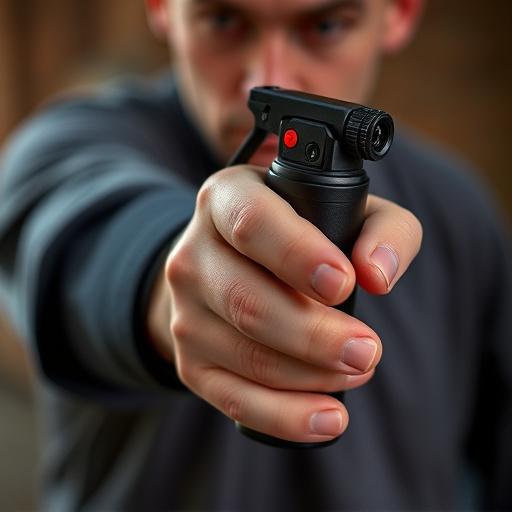To effectively utilize pepper spray for self-defense, understand its composition (capsaicin) and usage, selecting a legal, potent (0.5%-2% capsaicin), compact, weather-resistant model suitable for daily carry if needed. Master best pepper spray self-defense techniques by practicing aiming, targeting sensitive areas (eyes, nose, mouth), maintaining distance until effect takes hold, and combining with hand-to-hand combat if required. Ensure legal compliance and safety by researching local laws, training in different scenarios, and responsible usage focused on non-lethal incapacitation for escape or help.
“Uncover the power of pepper spray as a personal defense mechanism in this comprehensive guide. From understanding its chemical composition to mastering effective self-defense techniques, we explore everything you need to know about choosing and using pepper spray for maximum protection. Learn about legal considerations and safety precautions, ensuring you’re prepared with the best pepper spray self-defense techniques available. Protect yourself with knowledge.”
- Understanding Pepper Spray: The Chemical Composition and Its Effects
- Choosing the Right Pepper Spray for Personal Defense
- Effective Pepper Spray Self-Defense Techniques
- Legal Considerations and Safety Precautions When Using Pepper Spray
Understanding Pepper Spray: The Chemical Composition and Its Effects
Pepper spray, a potent self-defense tool, is designed to incapacitate an attacker temporarily. Its primary active ingredient is capsaicin, the same compound that gives chili peppers their heat and sting. This chemical irritates the eyes, nose, and respiratory system, leading to temporary blindness, coughing, and difficulty breathing. The effects typically last for about 2-5 minutes, providing users with precious time to escape or de-escalate a situation.
When considering the best pepper spray self-defense techniques, understanding its composition is key. Pepper spray comes in various forms, from small handheld canisters to more advanced models equipped with holsters and safety features. Users should practice aiming techniques and familiarize themselves with the spray’s range and effectiveness. Regular maintenance and knowledge of local laws regarding pepper spray possession are also essential aspects of responsible self-defense preparation.
Choosing the Right Pepper Spray for Personal Defense
When considering pepper spray as a self-defense mechanism, selecting the right product is paramount. The best pepper spray for self-defense should offer potent, long-lasting protection while adhering to legal restrictions. Active ingredients vary, but capsaicin, the primary irritant, is most common. Concentrations range from 0.5% to 2%, with higher strengths providing more power. Look for a product designed for personal safety, featuring a compact, easy-to-use design that allows quick deployment in stressful situations.
Additionally, consider factors like weather resistance and durability, especially if you plan to carry it daily. Some models include holsters or keychains for convenience. Regular training in best pepper spray self-defense techniques is equally vital. Practice aiming and deploying the spray effectively while maintaining safety and legal awareness.
Effective Pepper Spray Self-Defense Techniques
When it comes to the best pepper spray self-defense techniques, knowledge and practice are key. Understanding how to deploy pepper spray effectively can significantly enhance your ability to deter and escape potential threats. Start by familiarizing yourself with the type of pepper spray you have, its range, and activation mechanism. Practice aiming at various targets—both in open spaces and tight corners—to ensure accuracy under stress.
During a confrontation, aim for the attacker’s eyes, nose, or mouth to maximize discomfort and disorientation. Remember that pepper spray is designed to temporarily incapacitate, so use it strategically. Apply enough pressure to expel the canister’s contents but not so much as to risk hitting yourself or bystanders. Stay back far enough from your assailant to allow the spray to take effect before closing the distance for hand-to-hand combat if necessary.
Legal Considerations and Safety Precautions When Using Pepper Spray
When considering pepper spray as a self-defense mechanism, it’s crucial to understand the legal implications and safety precautions involved in its use. The legality of carrying and using pepper spray varies significantly across regions, so individuals must familiarize themselves with local laws to ensure compliance. In many jurisdictions, pepper spray is classified as a weapon, subject to strict regulations. Possessing and employing such a substance can result in severe penalties, including fines and imprisonment, especially if used inappropriately or against prohibited targets like law enforcement officers or emergency responders.
Safety precautions are paramount when utilizing pepper spray for self-defense. Users should receive proper training on its application to minimize the risk of accidental discharge or misdirected use. It’s recommended to practice different scenarios to ensure confident handling. Additionally, individuals should consider the range and effectiveness of their chosen pepper spray, as factors like wind direction and distance can impact its performance. Responsible usage involves aiming for non-lethal areas to incapacitate an assailant temporarily, allowing individuals to escape or seek help.
Pepper spray self-defense has proven to be a powerful tool for personal safety, offering individuals an effective means to deter and disable attackers. By understanding its chemical composition, choosing the right spray, and mastering the best pepper spray self-defense techniques, users can significantly improve their ability to protect themselves in various situations. Always remember to prioritize safety and adhere to legal guidelines when carrying and using pepper spray, ensuring it remains a reliable deterrent.
